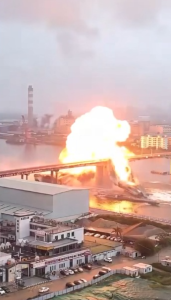
BREAKING: Newly Built Bridge in China Collapses — Dramatic Failure Raises Safety Alarms
Less than seven months after its grand opening, a major bridge in southwestern China has partially collapsed in a dramatic landslide-triggered failure. The incident, which has immediately gone viral online, has raised critical concerns over rapid infrastructure expansion in geologically unstable regions.
What Happened
-
The Hongqi Bridge, a 758-meter-long elevated structure in Sichuan Province, partially collapsed on November 11, 2025. The Washington Post+2The Guardian+2
-
According to local authorities, the collapse was caused by a landslide on the mountainside adjacent to the bridge. Wikipedia+1
-
The day before the collapse, officials had already closed the bridge to traffic. Visible cracks had appeared in nearby roads, raising red flags. The Washington Post
-
Video circulating online shows huge plumes of dust rising as sections of the bridge’s roadbed give way, concrete slabs break, and part of the structure falls into the river below. The Washington Post+1
-
Miraculously, no casualties have been reported so far. People.com
Background: Why This Bridge Mattered
-
The Hongqi Bridge spans part of China National Highway 317, a key route linking Sichuan Province with Tibet. Wikipedia
-
It’s not just any bridge. At its highest point, one of its pillars reaches 172 meters, making it a significant engineering feat. Wikipedia+1
-
Construction was completed earlier in 2025 — the bridge officially opened on April 13, 2025. Wikipedia
-
The project was led by the Sichuan Road & Bridge Group, part of China’s aggressive infrastructure drive in remote and mountainous regions. Wikipedia
Immediate Reactions and Key Concerns
-
Safety and Oversight
-
The bridge collapse is fueling renewed scrutiny over China’s rapid infrastructure expansion, especially in areas prone to geological hazards. The Washington Post
-
Experts are questioning whether slope stability and soil risk were adequately considered during construction and whether long-term risk mitigation was ignored.
-
-
Engineering & Design Critique
-
Some engineers and commentators are speculating that the design did not sufficiently account for landslide risk, or that the construction quality was compromised. Wikipedia
-
Critics also note the irony: a bridge so new, built at high cost and high ambition, failing so soon.
-
-
Rapid Development Trade-Offs
-
This incident underscores a broader tension in China’s development model: the push for connectivity and economic growth in remote areas vs. the inherent risk of building in dangerous terrain.
-
China has poured massive investments into connecting its mountainous regions, especially around Sichuan and Tibet, but terrain instability remains a real and persistent threat.
-
-
Public & Social Media Response
-
Videos and posts have exploded across Chinese social media platforms, with netizens stunned by the scale and suddenness of the collapse. Reddit+1
-
Some users are calling it a “tofu project” — slang used in China to describe poorly built infrastructure that crumbles easily. Reddit
-
Others are demanding accountability and transparency, questioning how such a major structure could fail so soon.
-
-
Government Response
-
Local government officials evacuated the bridge when cracks began to appear. Wikipedia
-
Authorities have emphasized that the landslide was the primary cause, denying that the failure indicates broader structural flaws. Wikipedia
-
A formal investigation is expected to follow, and experts will likely assess slope stability, design assumptions, and construction quality.
-
Wider Implications
-
Regional Connectivity Risk: This bridge was a vital transportation link. Its collapse disrupts a key national highway, reminding everyone how fragile infrastructure can be — even when it’s brand new.
-
Infrastructure Boom Under Pressure: China’s push to build quickly and in difficult terrain comes with high risk. The Hongqi collapse may trigger more rigorous safety audits or slower approvals in future mountain-area projects.
-
Public Trust: For people in the region and beyond, this failure raises trust questions. If a high-profile bridge can collapse so soon, what about smaller, less visible bridges?
-
Economic Impact: Beyond the structural loss, the collapse could slow down travel, trade, and local economies that depend on that route. Repair or reconstruction will likely be costly and time-consuming.
Historical Context & Related Incidents
This isn’t the only bridge failure making headlines lately. A few other examples:
-
In Kherson, Ukraine, a partially destroyed bridge has trapped about 1,000 residents, following a reported airstrike. Interfax-Ukraine
-
In Keningau, Malaysia, an old wooden bridge collapsed, cutting off hundreds of villagers and forcing them to take a lengthy detour. Malay Mail
-
In Kazakhstan, the Shnaider Bridge in Ust-Kamenogorsk collapsed despite recent multimillion-tenge repairs, raising questions about infrastructure maintenance. Tengrinews+1
-
Earlier this year in South Korea, a bridge under construction collapsed, killing four people and injuring six, highlighting the dangers in even high-development countries. Laotian Times
These incidents show that bridge safety is not just an isolated problem — it’s a global and systemic issue.
What’s Next
-
Investigation
-
Engineers, geologists, and safety inspectors will assess the site. They’ll examine slope stability, soil composition, and design parameters to understand exactly why the landslide happened.
-
Authorities must also look into whether early warning signs (like cracks or soil movement) were properly monitored—or ignored.
-
-
Reconstruction or Demolition
-
Depending on the damage assessment, the bridge could be partially rebuilt, or some sections may need to be demolished entirely.
-
Reinforcing the slope and adding landslide-protection measures may be necessary to make a rebuilt structure safe.
-
-
Policy Changes
-
The collapse could prompt tighter regulations for large infrastructure projects in unstable terrain.
-
There may be stricter requirements for geological surveys, slope stabilization measures, and ongoing monitoring—especially for bridges in mountainous areas.
-
-
Public Communication
-
Officials will need to communicate transparently about what went wrong and what will be done to prevent future collapses.
-
Trust-building will be key, especially because many people will now worry about the safety of other bridges.
-
Conclusion
The collapse of the Hongqi Bridge is a jarring reminder that even the most ambitious infrastructure projects carry real risk—particularly when built in geologically volatile regions. A bridge meant to symbolize progress, connectivity, and engineering prowess has become a cautionary tale: speed and ambition must be balanced with careful planning, rigorous inspections, and respect for the natural environment.
As investigations proceed and the world watches, one thing is clear: this is more than a structural failure. It’s a moment for reflection on how we build, where we build, and what happens when human ambition meets nature’s unpredictability

